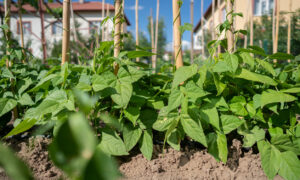We independently research, review, and recommend the best products. If you buy something through our links, we may earn a commission. Learn more.
Companion planting is a topic that often divides gardeners. Some swear by its benefits, while others dismiss it as nothing more than superstition. In this article, we’ll dive into the discussion and try to make sense of this sometimes-confusing subject for the novice gardener. From the general concept of companion planting to its benefits and tips, we’ll cover everything you need to know—including some discussion around its legitimacy as a scientific approach to gardening.
Contents
What is companion planting?
Companion planting is the practice of growing different plants together in proximity to enhance their growth and yields. The idea behind this method is that certain plant combinations can provide mutually beneficial outcomes, such as improved soil health, pest control, and increased pollination. Many gardeners believe this synergy can promote better growth, higher yields, and reduce issues.
For example, someone might plant beans with corn to provide a natural support system, as the nitrogen-fixing beans can improve soil health. Similarly, planting certain flowers near vegetables can attract pollinators, improving pollination and reducing the need for pesticides.
You can think of companion planting as a holistic approach to gardening that seeks to create harmony between different plants and the environment in which they grow.
Beneficial companions

When selecting plants to grow together, you’ll want to first consider the relationship between the two. Some plants have a positive, symbiotic relationship and are therefore considered beneficial companions, but not all partnerships are made equal.
For example, planting marigolds near tomatoes typically deters harmful pests, such as hornworms from attacking the tomatoes. Likewise, planting basil near tomatoes can improve flavour and health.
One of my favourite companions is garlic and roses, as the strong, vampire-killing scent can deter rose pests, such as aphids. I always plant herbs like basil, rosemary and thyme close to most of my vegetables as they act as natural insect repellents.
To give you a better idea of beneficial companions, I’ve outlined 20 plants and a few of their perfect partners (be mindful there are many more!):
| Plant | Good companions |
| Basil | Oregano, Peppers, Tomatoes |
| Beetroot | Beans, Cabbage, Lettuce, Garlic, Leeks |
| Cabbage Family | Beans, Beetroot, Potatoes, Swiss Chard |
| Carrots | Cabbage, Chives, Parsley, Peppers |
| Cucumber | Cabbage, Lettuce, Peas, Tomatoes |
| Dill | Cabbage, Corn, Lettuce, Cucumber |
| Garlic | Beetroot, Cabbage, Spinach, Tomatoes |
| Kale | Cabbage Family |
| Lettuce | Beetroot, Cabbage, Onion, Radish, Sage |
| Parsley | Carrots, Chives, Corn, Peas, Sage |
| Peas | Carrots, Cucumber, Spinach, Squash |
| Peppers | Basil, Carrots, Onion, Peas, Rosemary |
| Potatoes | Beans, Cabbage, Marigolds |
| Radishes | Beans, Lettuce, Peas, Squash |
| Rosemary | Beans, Cabbage, Peppers, Thyme |
| Sage | Anything! |
| Spinach | Cabbage, Leeks, Lettuce, Sage, Strawberry |
| Swiss Chard | Beans, Cabbage, Garlic, Onion, Sage |
| Thyme | Anything! |
| Tomatoes | Basil, Chives, Lettuce, Marigolds |
Incompatible plants
Incompatible plants, or “foes”, are those that have a negative impact on each other’s growth and development. This is due to various factors, such as competition for light, water, nutrients, allelopathic effects, and attraction of pests and diseases.
For example, many gardeners believe tomatoes and brassicas (such as broccoli and cauliflower) are incompatible because they both belong to the same family, making them susceptible to similar pests and diseases.
Similarly, dill and carrots tend to stunt each other’s growth and compete for nutrients when planted in proximity. The same goes for sunflowers as they have an allelopathic effect on nearby plants, producing chemicals that can inhibit growth.
Of course, some plant combinations won’t breed the best results, but it doesn’t always mean that your plants won’t grow at all. But more on that shortly.
In the meantime, here is a short list of “foe” combinations for a few plants:
- Asian Greens – Parsley
- Beans – Garlic
- Carrots – Dill
- Corn – Tomatoes
- Garlic – Peas
- Marigold – Beans
- Peas – Chives
- Peppers – Cabbage
- Potatoes – Tomato
- Radishes – Potatoes
- Squash – Cabbage
- Tomatoes – Potatoes
How scientific is companion planting?

Companion planting is always a hot topic on gardening forums and has actually been a widely accepted practice for centuries. In my opinion, it must have some truth behind it to have such staying power. Others might differ in their approach, but I tend to only focus on the beneficial planting combinations, as these make the most sense from experience.
When it comes to supposed ‘incompatible plant combinations’, I like to think of them as neighbours. Not all neighbours get along, but that doesn’t mean life can’t go on. For example, in the past I have inter-planted beans with peppers, and garlic near peas, both of which are supposed to be incompatible. The plants still grew, albeit not as successfully as in previous seasons—but there were no major issues.
It’s always best to give your plants the best conditions to thrive, but if limited space or other circumstances mean you must break the rules, don’t stress about it too much. Grow as you mean to go on!
Benefits of companion planting
Companion planting isn’t just about aesthetics. There are many practical benefits too, particularly when it comes to insect control.
For example, I plant marigolds close to tomatoes because they release a chemical that deters harmful nematodes from attacking the roots. Likewise, you’ll often find basil nearby in my garden, as I’ve found they improve the health and flavour of my tomatoes.
One of the biggest benefits of companion planting is the promotion of beneficial insects. Ladybugs, for example, love to feast on aphids, so planting dill, fennel, or coriander in proximity keeps our lovely, dotted friends coming back. Also, planting flowers like cosmos, sunflowers, and zinnias will attract pollinators like bees and butterflies, which will help to improve plant health.
Finally, you’ll want to think about reducing competition for resources like water, light, and nutrients. By strategically pairing complementary plants, you can avoid them tussling over the good stuff.
Companion planting tips
Ready to see your plants co-exist and thrive together? Here are a few of my favourite tips getting the best companion planting results:
- Start with the basics: Start by simply planting herbs and flowers among your vegetables. Calendula, oregano, basil, nasturtiums, and rosemary are all great options that don’t have a long list of foes.
- Practice good spacing: Overcrowding can lead to competition for nutrients, water, sunlight, and airflow, making plants more susceptible to pests and disease. Fortunately, many companion flowers and herbs are easy to prune, so you can cut them back as needed to give your veggies the space they need.
- Preparation: Before you start planting, take a moment to sketch out a plan. This way, you can avoid planting foes next to each other. Of course, you don’t have to set your plan in stone, but having a rough idea of what you’re doing beforehand will help you stay organised and avoid mistakes.






